Fossili dell'evoluzione dell'uomo La lista dei fossili dell'evoluzione dell'uomo comprende un elenco di alcuni dei più importanti ritrovamenti di fossili di ominidi relativi all'evoluzione umana, successivi alla separazione della linea che ha portato agli scimpanzé e classificati nella sottotribù Hominina.[1]
Non tutti quelli elencati possono essere considerati come appartenenti a diretti antenati dell'Homo sapiens ma, facendo parte di quello che i paleoantropologi chiamano cespuglio evolutivo umano,[2] sono comunque importanti nello studio dell'evoluzione della nostra specie. Una lista di questo tipo è sempre necessariamente incompleta e soggetta a continui aggiornamenti.
Nella lista seguente i fossili sono divisi in base all'epoca geologica a cui sono assegnati e disposti in ordine cronologico crescente in base all'età attribuita, ottenuta mediante datazione diretta, come la datazione al radiocarbonio, o indiretta come lo studio stratigrafico del luogo dove sono stati rinvenuti, o faunistico. Quando esistente viene riportato il codice con cui vengono inequivocabilmente identificati e tra parentesi il soprannome con cui il fossile è conosciuto. Ad esempio "AL 288-1" è conosciuto comunemente come Lucy; AL sta per Afar Locality (Località Afar) e 288-1 è il numero di inventario; spesso il codice è composto dal numero di inventario e da una sigla che identifica, in maniera abbreviata, il luogo di ritrovamento o altro.
Abbreviazioni
Di seguito sono riportati i significati delle principali sigle abbreviative delle località di ritrovamento. Nella lista i fossili sono associati alla specie alla quale sono normalmente attribuiti; quando questa attribuzione è dibattuta o non univoca, vengono riportate anche le designazioni alternative. I fossili evidenziati in verde sono gli olotipi della specie.
- AL - Afar Locality (Regione degli Afar, Etiopia)
- ARA-VP - Aramis, Vertebrate Paleontology (Paleontologia dei Vertebrati, sito Aramis, Valle dell'Awash, Etiopia)
- AT - Atapuerca, Sima de los Huesos (sito sulla Sierra de Atapuerca, Spagna)
- ATD - Atapuerca, Trinchera Gran Dolina (Trincea della Gran Dolina, Sierra de Atapuerca, Spagna)
- ATE - Atapuerca, Trinchera Sima del Elefante (Trincea di Sima del Elefante, Sierra de Atapuerca, Spagna)
- BAR - Baringo (Lago Baringo, Kenya)
- BOU-VP - Bouri, Vertebrate Paleontology (Paleontologia dei Vertebrati, sito Bouri, Valle dell'Awash, Etiopia)
- D - Dmanisi (Sito in Georgia)
- DNH - Drimolen Hominid (Ominidi di Drimolen, sito Sudafricano)
- IVPP - Institute of Vertebrate Paleonthology and Paleoanthropology (Istituto di Paleontologia dei Vertebrati e Paleoantropologia, Cina)
- KGA - Konso-Gardula (Sito in Etiopia)
- KNM - Kenya National Museum (Musei Nazionali del Kenya, dove sono conservati i reperti, seguito dalla località)
- KNM-ER - East Rudolf (Est del Lago Rodolfo, oggi Lago Turkana, Kenya)
- KNM-KP - Kanapoi (sito a sudovest del Lago Turkana, Kenya)
- KNM-LT - Lothagam (sito a sudovest del Lago Turkana, 55 km da Kanapoi, Kenya)
- KNM-TH - Tugen Hills (sito centro-orientale del Kenya)
- KNM-WT - West Turkana (Ovest del Lago Turkana, Kenya)
- LB - Liang Bua (Caverna dell'Isola di Flores, Indonesia)
- LD - Ledi-Geraru Research Project (Progetto di ricerca Ledi-Geraru, località nella Valle dell'Awash, Etiopia)
- LH - Laetoli Hominid (Ominidi di Laetoli, Tanzania)
- Lo - Lothagam (sito a sudovest del Lago Turkana, 55 km da Kanapoi, Kenya)
- MH - Malapa Hominid (Ominidi di Malapa, grotta Sudafricana)
- OH - Olduvai Hominid (Ominidi di Olduvai, Tanzania)
- SK - Swartkrans (Sito in Sudafrica)
- Sts, Stw - Sterkfontein (Sito in Sudafrica)
- TM - Transvaal Museum (Conserva i reperti, Sudafrica)
- TM - Toros-Menalla (Sito in Ciad)
Elenco dei fossili
Miocene
Miocene, piano Messiniano (7,246 – 5,332 Ma)
| Immagine
|
Nome
|
Età
del reperto
|
Specie
|
Data
della scoperta
|
Luogo del ritrovamento
|
Scopritore/i
|
Note
|
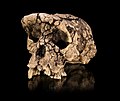
|
TM 266 1
(Toumai)
|
7,2 - 6,8 Ma
|
Sahelanthropus tchadensis
|
2001
|
Toros-Menalla, Ciad
|
Ahounta Djimdoumalbaye, del team di ricercatori condotto da Michel Brunet
|
[3]
|
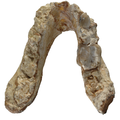
|
El Graeco
|
7,175
|
Graecopithecus freybergi
|
1944
|
Pyrgos, Atene, Grecia
|
Soldati tedeschi
|
[4]
|

|
BAR 1002'00
(Millennium man)
|
6,0 Ma
|
Orrorin tugenensis
|
2001
|
Tugen Hills, Kenya
|
Team di ricercatori condotto da Brigitte Senut e Martin Pickford
|
[5]
|
|
|
ALA-VP-2/10
|
5,8-5,2 Ma
|
Ardipithecus kadabba
|
1997-2000
|
Valle dell'Awash, Etiopia
|
Yohannes Haile-Selassie
|
[6]
|
Pliocene
Pliocene (5,332 – 2,588 Ma)
| Immagine
|
Nome
|
Età
del reperto
|
Specie
|
Data
della scoperta
|
Luogo del ritrovamento
|
Scopritore/i
|
Note
|

|
KNM-LT 329
(Mandibola di Lothagam)
|
5,0 - 4,2 Ma
|
Australopithecus anamensis
|
1967
|
Lago Turkana, Kenya
|
Arnold Lewis
Bryan Patterson
|
[7]
|
| Foto su Archive.li (JPG).
|
KNM-TH 13150 (Mandibola di Tabarin)
|
4,4 Ma
|
Ardipithecus ramidus ? Orrorin ?
|
1984
|
Tabarin, Lago Baringo, Kenya
|
Kiptalam Cheboi
|
[8]
|

|
ARA-VP-6/500
(Ardi)
|
4,4 Ma
|
Ardipithecus ramidus
|
1992
|
Valle dell'Awash, Etiopia
|
Yohannes Haile-Selassie, membro della squadra di ricercatori condotta da Tim White
|
[9]
|

|
KNM-KP 29281
|
4,1 Ma
|
Australopithecus anamensis
|
10-9-1994
|
Kanapoi, Kenya
|
Peter Nzube
|
[10]
|

|
KNM-KP 271
|
4,0 Ma
|
Australopithecus anamensis
|
1965
|
Kanapoi, Kenya
|
Bryan Patterson
|
[11]
|

|
Impronte fossili di Laetoli
|
3,66 Ma
|
Australopithecus afarensis
|
1976
|
Laetoli, Tanzania
|
Andrew Hill membro della squadra di ricercatori condotta da Mary Leakey
|
[12]
|

|
LH 4
|
3,8 - 3,6 Ma
|
Australopithecus afarensis
|
1974
|
Laetoli, Tanzania
|
Maundu Muluila
(Mary Leakey)
|
[13]
|

|
KNM-WT 40000
|
3,5 Ma
|
Kenyanthropus platyops ? Australopithecus afarensis ?
|
1999
|
Lomekwi, Kenya
|
Justus Erus, membro della squadra di ricercatori condotta da Meave Leakey
|
[14]
|

|
Stw 573
(Little foot)
|
3,67 Ma
|
Australopithecus sp.
|
1994
|
Sterkfontein, Sudafrica
|
Ronald J. Clarke
|
[15]
|
|
|
AL 129-1
(Johanson's Knee)
|
3,4 Ma
|
Australopithecus afarensis
|
30-10-1973
|
Hadar, Etiopia
|
Donald Johanson
|
[16]
|

|
DIK-1/1
(Selam)
|
3,3 Ma
|
Australopithecus afarensis
|
2000
|
Dikika, Etiopia
|
Zeresenay Alemseged e Tilahun Gebreselassie
|
[17]
|

|
AL 200-1
|
3,2 - 3,0 Ma
|
Australopithecus afarensis
|
1974
|
Hadar, Etiopia
|
Donald Johanson
|
[18]
|
|
|
KT-12/H1
(Abel)
|
3,4 - 3,0 Ma
|
Australopithecus bahrelghazali
|
1995
|
Koro Toro, Ciad
|
Michel Brunet
|
[19]
|

|
AL 288-1
(Lucy)
|
3,2 Ma
|
Australopithecus afarensis
|
30-11-1974
|
Hadar, Etiopia
|
Donald Johanson
|
[20]
|

|
AL 444-2
|
3,0 Ma
|
Australopithecus afarensis
|
1991
|
Hadar, Etiopia
|
Yoel Rak
|
[21]
|
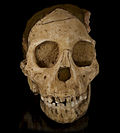
|
Taung 1
(Taung Child)
|
3,0 - 2,5 Ma
|
Australopithecus africanus
|
1924
|
Taung, Sudafrica
|
Raymond Dart
|
[22]
|
Foto su
cdn.sci-news.com (JPG) (archiviato dall'url originale il 7 gennaio 2018).
|
LD 350-1
|
2,8 - 2,75 Ma
|
Homo habilis ?
Homo rudolfensis ?
|
2013
|
Ledi-Geraru, Etiopia
|
Chalachew Seyoum
|
[23]
|

|
STS 71
|
2,8 - 2,5 Ma
|
Australopithecus africanus
|
13-11-1947
|
Sterkfontein, Sudafrica
|
Robert Broom
John T. Robinson
|
[24][25]
|
| Foto su eFossils.org.
|
STS 52
|
2.8 - 2.3 Ma
|
Australopithecus africanus
|
1949
|
Sterkfontein, Sudafrica
|
John T. Robinson
|
[26]
|
Pleistocene inferiore
Pleistocene inferiore (2,588 Ma - 781 ka)
| Immagine
|
Nome
|
Età
del reperto
|
Specie
|
Data
della scoperta
|
Luogo del ritrovamento
|
Scopritore/i
|
Note
|

|
STS 5
(Mrs. Ples)
|
2,5 Ma
|
Australopithecus africanus
|
18-4-1947
|
Sterkfontein, Sudafrica
|
Robert Broom,
John T. Robinson
|
[27]
|
Foto su
antropogenez.ru (JPG).
|
Omo 18-1967-18
|
2,5 Ma
|
Paranthropus aethiopicus
|
1967
|
Valle dell'Omo, Etiopia
|
Camille Arambourg
Yves Coppens
|
[28]
|

|
KNM WT 17000
(The Black Skull)
|
2,5 Ma
|
Paranthropus aethiopicus
|
29-8-1985
|
Turkana, Kenya
|
Alan Walker
|
[29]
|

|
TM 1517
|
2,0 Ma
|
Paranthropus robustus
|
8-6-1938
|
Kromdraai, Sudafrica
|
Gert Terblanche
|
[30]
|

|
SK 48
|
2,0 -1,5 Ma
|
Paranthropus robustus
|
1948
|
Swartkrans, Sudafrica
|
Fourie
(Robert Broom)
|
[31]
|

|
STW 53
|
2,0 - 1,5 Ma
|
Homo gautengensis (?)
Homo habilis (?)
|
1976
|
Sterkfontein, Sudafrica
|
A. R. Hughes
|
[32][33]
|
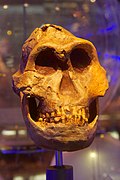
|
DNH 7
(Eurydice)
|
2,0 - 1,5 Ma
|
Paranthropus robustus
|
1994
|
Drimolen, Sudafrica
|
André Keyser
|
[34]
|

|
MH1
(Karabo)
|
1,95-1,78 Ma
|
Australopithecus sediba
|
15-8-2008
|
Malapa, Sudafrica
|
Lee R. Berger
|
[35]
|
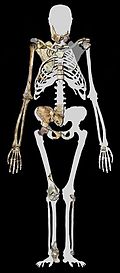
|
MH2
|
1,95-1,78 Ma
|
Australopithecus sediba
|
4-9-2008
|
Malapa, Sudafrica
|
Lee R. Berger
|
[36]
|

|
KNM-ER 1470
|
1,9 Ma
|
Homo rudolfensis
|
8-1972
|
Koobi Fora, Kenya
|
Bernard Ngeneo
|
[37]
|

|
KNM-ER 1813
|
1,9 Ma
|
Homo habilis
|
1973
|
Koobi Fora, Kenya
|
Kamoya Kimeu
|
[38]
|

|
OH 5
(Zinj o Nutcracker Man)
|
1,8 Ma
|
Paranthropus boisei
|
17- 7-1959
|
Gola di Olduvai, Tanzania
|
Mary Leakey
|
[39].
|

|
OH 24
(Twiggy)
|
1,8 Ma
|
Homo habilis
|
10-1968
|
Gola di Olduvai, Tanzania
|
Peter Nzube
|
[40]
|

|
D2700
|
1,8 Ma
|
Homo georgicus
(Homo erectus s.l. ?)
|
2001
|
Dmanisi, Georgia
|
David Lordkipanidze
|
|

|
SK 847
|
1,8 - 1,5 Ma
|
Homo habilis
(o Homo ergaster)
|
23-7-1949
|
Swartkrans, Sudafrica
|
Ronald J. Clarke
|
[41][42]
|
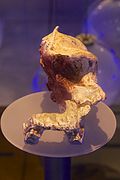
|
SK 46
|
1,8 - 1,5 Ma
|
Paranthropus robustus
|
1936
|
Swartkrans, Sudafrica
|
Assistente di
Robert Broom
|
[43]
|
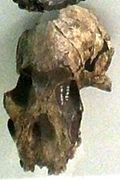
|
KNM-WT 17400
|
1,77 Ma
|
Paranthropus boisei
|
|
Lago Turkana, Kenya
|
(Pubblicato da
Richard Leakey)
|
|

|
OH 7
(Jonny's Child)
|
1,75 Ma
|
Homo habilis
|
4-11-1960
|
Gola di Olduvai, Tanzania
|
Jonathan Leakey
|
[44]
|

|
OH 8
|
1,75 Ma
|
Homo habilis
|
1960
|
Gola di Olduvai, Tanzania
|
Assistente di
Louis Leakey
|
[45]
|

|
KNM-ER 3733
|
1,75 Ma
|
Homo ergaster
|
1975
|
Koobi Fora, Kenya
|
Bernard Ngeneo
|
[46]
|

|
KNM-ER 406
|
1,70 Ma
|
Paranthropus boisei
|
1969
|
Koobi Fora, Kenya
|
Richard Leakey
|
[47]
|
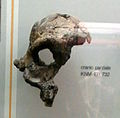
|
KNM-ER 732
|
1,70 Ma
|
Paranthropus boisei
|
1970
|
Koobi Fora, Kenya
|
Richard Leakey
|
[48]
|
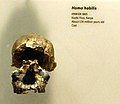
|
KNM-ER 1805
|
1,70 Ma
|
Homo habilis
|
1973
|
Koobi Fora, Kenya
|
Paul Abell
|
|

|
KNM-ER 23000
|
1,70 Ma
|
Paranthropus boisei
|
1990
|
Koobi Fora, Kenya
|
Benson Kyongo
|
|
| Foto su eFossils.org.
|
OH 13
(Cenerentola)
|
1,60 Ma
|
Homo habilis
|
1963
|
Gola di Olduvai, Tanzania
|
N. Mbuika
(Louis e Mary Leakey)
|
[49]
|

|
NMT-W64-160
(Peninj 1)
|
1,50 Ma
|
Paranthropus boisei
|
11-1-1964
|
Peninj, Tanzania
|
Richard Leakey
Glynn Isaac
|
[50]
|

|
KNM-ER 992
|
1,50 Ma
|
Homo ergaster
|
1971
|
Turkana, Kenya
|
Richard Leakey,
G. Isaac
|
[51]
|

|
KNM-ER 3883
|
1,50 Ma
|
Homo ergaster
|
1976
|
Koobi Fora, Kenya
|
Richard Leakey
M. Muluila
|
[52]
|

|
KNM-WT 15000
(Ragazzo di Turkana)
|
1,50 Ma
|
Homo ergaster
|
8-1984
|
Turkana, Kenya
|
Kamoya Kimeu
|
[53]
|
|
|
KGA 10-525
|
1,40 Ma
|
Paranthropus boisei
|
1993
|
Konso, Etiopia
|
A. Amzaye
|
[54]
|

|
OH 9
(Chellean Man)
|
1,2 - 1,1 Ma
|
Homo erectus
|
2-12-1960
|
Gola di Olduvai, Tanzania
|
Louis Leakey
|
[55]
|

|
Sangiran 2
(Pithecanthropus II)
|
1,0 Ma
|
Homo erectus
|
1937
|
Sangiran, Indonesia
|
Gustav H. R. von Koenigswald
|
[56].
|

|
Sangiran 4
(Pithecanthropus IV)
|
1,0 Ma
|
Homo erectus
|
1939
|
Sangiran, Indonesia
|
Gustav H. R. von Koenigswald
|
[57]
|
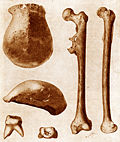
|
Uomo di Giava
(Trinil 1, Trinil 2 e Trinil 3)
|
1,0 - 0,7 Ma
|
Homo erectus
|
10-1891
|
Trinil, Indonesia
|
Eugène Dubois
|
[58]
|
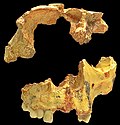
|
ATD6-15 e ATD6-69
Niño de Gran Dolina.
|
900 ka
|
Homo antecessor
|
1994
|
Atapuerca, Spagna
|
Aurora Martín Nájera
|
[59]
|

|
Uomo di Pechino
|
800 - 400 ka
|
Homo erectus pekinensis
|
1921 - 1966
|
Zhoukoudian, Cina
|
O. Zdansky (1921)
B. Bohlin (1928-1929)
W. Pei (1930-1937)
(Pubblicato da
Davidson Black)
|
[60]
|

|
Sangiran 17
|
800 ka
|
Homo erectus
|
13-09-1969
|
Sangiran, Indonesia
|
Towikromo
|
[61]
|
Pleistocene medio
Pleistocene medio (781–126 ka)
| Immagine
|
Nome
|
Età
del reperto
|
Specie
|
Data
della scoperta
|
Luogo del ritrovamento
|
Scopritore/i
|
Note
|

|
Ternifine 1
Ternifine 2
Ternifine 3
|
700 ka
|
Homo erectus
|
1954
|
Ternifine, Algeria
|
Camille Arambourg
|
[62]
|

|
Bodo 1
|
600 ka
|
Homo heidelbergensis ??
o Homo erectus ??
o Homo bodoensis??
|
1976
|
Bodo D'ar, Etiopia
|
A. Asfaw
P. Whitehead
C. Wood
|
[63]
|
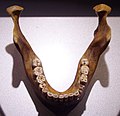
|
Mauer 1
|
600 ka
|
Homo heidelbergensis
|
21-10-1907
|
Mauer, Germania
|
Daniel Hartmann
|
[64]
|
|
|
Heidel
|
586 ka
|
Homo Aeserniensis
(Homo Heidelbergensis?)
|
2014
|
Isernia, Italia
|
|
[65]
|

|
Argil
(Uomo di Ceprano)
|
500 - 400 ka
|
Homo cepranensis
(Homo antecessor?
Homo heidelbergensis?)
|
13-3-1994
|
Ceprano, Italia
|
Italo Biddittu
|
[66]
|

|
Saldanha 1
(Uomo di Saldanha)
|
500 - 200 ka
|
Homo heidelbergensis
|
1953
|
Elandsfontein, Sudafrica
|
Keith Jolly
|
[67]
|

|
Cranio del Gawis
|
500 - 200 ka
|
Homo erectus ?
Homo sapiens ?
|
2006
|
Gawis, Etiopia
|
Asahmed Humet
|
[68]
|
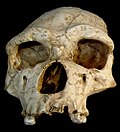
|
Arago 21
|
450 ka
|
Homo heidelbergensis ?
Homo erectus autavelensis ?
Uomo di Tautavel?
|
1971
|
Grotta dell'Arago, Francia
|
Henry de Lumley
Marie Antoinette de Lumley
|
[69]
|
| immagine su humanorigins
|
IVPP PA 830
|
412±25 ka
|
Homo erectus
|
1980
|
Grotta di Longtan, Cina
|
Huang Wanpo e al.
|
[70]
|
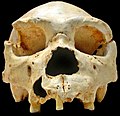
|
AT 700
o Cranio 5
o Miguelón
|
400 ka
|
Homo heidelbergensis
|
1992
|
Sima de los Huesos, Atapuerca, Spagna
|
J. M. Bermúdez
J. L. Arsuaga
E. Carbonell
|
[71].
|

|
Steinheim 1
o Cranio di Steinheim
o Homo steinheimensis
|
350 ka
|
Homo heidelbergensis
|
1933
|
Steinheim an der Murr, Germania
|
Karl Sigrist
|
[72]
|
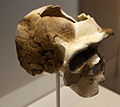
|
Ndutu
|
350 ka
|
Homo heidelbergensis
|
1973
|
lago Ndutu, Tanzania
|
Gruppo di ricerca di
I. M. Mendizábal
|
[73]
|

|
Petralona 1
|
350 - 150 ka
|
Homo heidelbergensis ?
Homo erectus ?
Homo neanderthalensis ?
|
1960
|
Grotta di Petralona, Grecia
|
Christos Sariannidis
|
[74]
|

|
Jebel Irhoud 1
|
300 ka
|
Homo sapiens
|
1961
|
Jebel Irhoud, Marocco
|
Cavatore locale
|
[75]
|
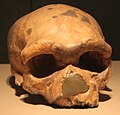
|
Cranio di Dali
|
260 - 200 ka
|
Homo erectus ?
Homo sapiens ?
|
1978
|
Jiefang, Contea di Dali, Cina
|
Shuntang Liu
|
[76]
|

|
Kabwe 1
o Broken Hill 1
o Rhodesian Man
|
300 - 125 ka
|
Homo heidelbergensis
|
1921
|
Kabwe, Zambia
|
Tom Zwiglaar
|
[77]
|

|
Cranio di Salé
|
250 - 200 ka
|
Homo erectus ?
Homo sapiens ?
|
1971
|
Salé, Marocco
|
Cavatori locali
|
[78]
|

|
Ngandong 7
|
250 - 70 ka
|
Homo erectus
|
1932
|
Ngandong, Giava, Indonesia
|
C. ter Haar e Gustav Heinrich Ralph von Koenigswald
|
[79]
|

|
Omo 1
|
195 ka
|
Homo sapiens
|
1967
|
Omo Kibish, Etiopia
|
Gruppo di ricerca di
Richard Leakey
|
[80]
|

|
Omo 2
|
190 ka
|
Homo sapiens
|
1967
|
Omo Kibish, Etiopia
|
Gruppo di ricerca di
Richard Leakey
|
[81].
|

|
Uomo di Altamura
|
175 - 125 ka
|
Homo neanderthalensis
|
1993
|
Grotta di Lamalunga, Altamura, Italia
|
CARS - Centro Altamurano
Ricerche Speleologiche
|
[82]
|

|
BOU-VP-16/1
|
160 ka
|
Homo sapiens
|
1997
|
Bouri, Etiopia
|
Tim White
|
[83]
|

|
Mandibola di Xiahe
|
160 ka
|
Homo di Denisova
|
1980
|
grotta di Baishiya, Cina
|
monaco Buddista
|
[84]
|

|
Cranio di Harbin
o (Uomo Drago, Dragon man)
|
146 ka
|
Homo di Denisova
|
1933
|
Harbin, Cina
|
Operaio
|
[85]
|

|
Krapina C
Krapina 3
|
130 ka
|
Homo neanderthalensis
|
1899
|
Krapina, Croazia
|
Dragutin Gorjanović-Kramberger
|
[86]
|

|
Saccopastore 1
(Uomo di Saccopastore)
|
130 - 100 ka
|
Homo neanderthalensis
|
1929
|
Sacco Pastore, Italia
|
Mario Grazioli
|
[87]
|
Pleistocene superiore
Pleistocene superiore (126 – 11,7 ka)
| Immagine
|
Nome
|
Età
del reperto
|
Specie
|
Data
della scoperta
|
Luogo del ritrovamento
|
Scopritore/i
|
Note
|

|
Tabun 1
|
122 - 50 ka
|
Homo neanderthalensis
|
1929-1934
|
Grotta di Tabun, Monte Carmelo, Israele
|
Yusra
Gruppo di ricerca di D. A. E. Garrod
|
[88]
|

|
LH 18
o Cranio di Ngaloba
|
120 ka
|
Homo sapiens
|
1976
|
Laetoli, Tanzania
|
Gruppo di ricerca di
Mary Leakey
|
[89]
|

|
Qafzeh 6
|
120 - 90 ka
|
Homo sapiens
|
1933
|
Grotta di Qafzeh, Israele
|
R. Neuville
|
[90]
|

|
Skhūl V
|
120 - 80 ka
|
Homo sapiens
|
1932
|
Grotta di Skhul, Monte Carmelo, Israele
|
T. McCown
H. L. Moivus
|
[91]
|
|
|
Skhūl IX
|
120 - 80 ka
|
Homo sapiens ?
|
1932
|
Es Skhul, Monte Carmelo, Israele
|
T. McCown
H. L. Moivus
|
|

|
Qafzeh 9
|
100 - 90 ka
|
Homo sapiens
|
1967
|
Grotta di Qafzeh, Israele
|
T. McCown
H. L. Moivus
|
[92]
|

|
LB-1
Lo Hobbit o Flo
o Little Lady of Flores
|
80 ka
|
Homo floresiensis
|
2003
|
Liang Bua Isola di Flores, Indonesia
|
Wahyu Saptomo, Benjamin Tarus, Thomas Sutikna, Rokus Due Awe, Michael Morwood e Raden Soejono
|
[93]
|

|
La Ferrassie 1
|
70 - 50 ka
|
Homo neanderthalensis
|
1909
|
La Ferrassie, Francia
|
Louis Capitan
Denis Peyrony
|
[94]
|

|
Gibraltar 1
|
70 - 45 ka
|
Homo neanderthalensis
|
1848
|
Rocca di Gibilterra, Regno Unito
|
Lieutenant Flint
|
[95]
|

|
La Quina H5
|
65 ka
|
Homo neanderthalensis
|
1911
|
La Quina, Francia
|
Henry Martin
|
[96]
|

|
La Quina H18
|
65 ka
|
Homo neanderthalensis
|
1915
|
La Quina, Francia
|
Henry Martin
|
[97]
|
|
|
Amud 7
|
61 ka
|
Homo neanderthalensis
|
1992
|
Israele
|
Grotta di Amud, Israele
|
[98]
|

|
Guattari 1
Circeo 1
|
60 - 40 ka
|
Homo neanderthalensis
|
1939
|
Grotta Guattari, Monte Circeo, Italia
|
Alessandro Guattari
|
[99]
|

|
Ngandong 6
Solo V
|
53 - 27 ka
|
Homo erectus
|
1932
|
Ngandong, Indonesia
|
C. ter Haar e Gustav H. R. von Koenigswald
|
[100]
|
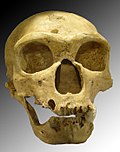
|
La Chapelle-aux-Saints 1
|
50 ka
|
Homo neanderthalensis
|
3-8-1908
|
Bouffia Bonneval, La Chapelle-aux-Saints, Francia
|
Amadee Bouyssonie
Jean Bouyssonie
Josef Bonneval
|
[101]
|

|
Neanderthal 1
|
50 - 40 ka
|
Homo neanderthalensis
|
1856
|
Grotta Kleine Feldhofer, Valle di Neander, Germania
|
Minatore
|
[102]
|
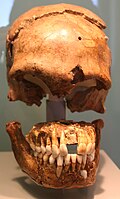
|
Le Moustier 1
|
50 - 40 ka
|
Homo neanderthalensis
|
1909
|
Le Moustier, Francia
|
Otto Hauser
|
[103]
|
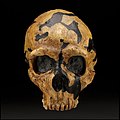
|
Shanidar 1
|
45 - 35 ka
|
Homo neanderthalensis
|
1961
|
Shanidar, Iraq
|
Ralph Solecki
|
[104]
|

|
Donna di Zlatý kůň
|
43 ka
|
Homo sapiens
|
1950
|
Zlatý kůň, Repubblica Ceca
|
|
[105]
|

|
Oase 2
|
41,5 - 39,5 ka
|
Homo sapiens ?
Homo neanderthalensis ?
|
2002
|
Peștera cu Oase, Romania
|
Stefan Milota, Ricardo Rodrigo, Oana Moldovan e João Zilhão
|
[106]
|

|
Amud 1
|
41 ka
|
Homo neanderthalensis
|
1961
|
Grotta di Amud, Israele
|
Hisashi Suzuki
|
[107]
|
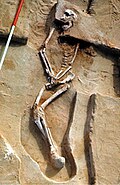
|
LM3
(Mungo Man)
|
40 ka
|
Homo sapiens
|
26-2-1974
|
Lago Mungo, Australia
|
Jim Bowler
|
[108]
|

|
Hofmeyr 1
(Teschio di Hofmeyr)
|
40 - 33 ka
|
Homo sapiens
|
1952
|
Hofmeyr, Sudafrica
|
Frederick E. Grine
|
[109]
|
|
|
Kostenki-14
|
38.700-36.200
|
Homo sapiens
|
1954
|
Kostyonki–Borshchyovo, Russia
|
Aleksandr Nikolaevič Rogačëv
|
[110]
|

|
Cro-Magnon 1
|
32 - 30 ka
|
Homo sapiens
|
1868
|
Abri Cro-Magnon, Francia
|
Louis Lartet
|
[111]
|

|
Predmost 3
|
26 ka
|
Homo sapiens
|
1894
|
Predmosti, Cecoslovacchia
|
K. J. Maska
|
[112]
|

|
Minatogawa 1
o Uomo di Minatogawa
|
18,2 - 16,6 ka
|
Homo sapiens
|
1970
|
Minatogawa, Naha, Giappone
|
Seiho Oyama
|
[113]
|

|
Uomo di Chancelade
|
17 - 12,6 ka
|
Homo sapiens
|
1888
|
Grotta di Raymonden, Chancelade, Francia
|
|
[114]
|

|
Cranio di Iho Eleru
|
16.3-11.7 ka
|
Homo sapiens
|
1965
|
Iho Eleru, Ondo, Nigeria
|
Thurstan Shaw
|
[115]
|

|
Villabruna 1
o Cacciatore della Val Rosna
|
14 ka
|
Homo sapiens
|
1987
|
Ripari Villabruna, Veneto, Italia
|
Aldo Villabruna
|
[116]
|
|
|
Cranio di Talgai
|
13,5 ka
|
Homo sapiens
|
1884
|
Talgai, Queensland, Australia
|
William Naish
|
[117]
|
Olocene
Olocene (da 11700 anni)
| Immagine
|
Nome
|
Età
del reperto
|
Specie
|
Data
della scoperta
|
Luogo del ritrovamento
|
Scopritore/i
|
Note
|

|
Lapa Vermelha IV Hominid
o Luzia
|
11 500 anni
|
Homo sapiens
|
1976
|
Lapa Vermelha, Belo Horizonte, Brasile
|
Annette Laming-Emperaire
|
[118]
|

|
Donna di La Brea
|
10 250 anni
|
Homo sapiens
|
1914
|
La Brea Tar Pits, Los Angeles, Stati Uniti d'America
|
A. L. Kroeber
|
[119]
|

|
Kow Swamp 1
|
10 000 anni
|
Homo sapiens
|
1968
|
Kow Swamp, Victoria, Australia
|
A. Alan Thorne e Phillip Macumber
|
[120]
|
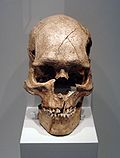
|
Uomo di Combe-Capelle
|
9 600 anni
|
Homo sapiens
|
1909
|
Couze-et-Saint-Front, Francia
|
Otto Hauser
|
[121]
|

|
GC1
Uomo di Cheddar
|
9.230-8.930
anni
|
Homo sapiens
|
1903
|
Caverna di Gough, Regno Unito
|
Operai
|
[122]
|
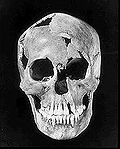
|
Minnesota Woman
|
8 300 anni
|
Homo sapiens
|
1931
|
Pelican Rapids, Stati Uniti d'America
|
Operai
|
[123]
|

|
Loschbour 1
Uomo di Loschbour
|
8 000 anni
|
Homo sapiens
|
1935
|
Löschbur, Waldbillig, Lussemburgo
|
Nicolas Schmit
|
[124]
|
|
|
Uomo di La Braña
|
7 000 anni
|
Homo sapiens
|
2006
|
La Braña,Valdelugueros, Spagna
|
Julio Manuel Vidal Encinas
|
[125]
|
|
|
Uomo di Asselar
|
6 390 anni
|
Homo sapiens
|
1927
|
Adrar degli Ifoghas, Mali
|
Théodore Monod, Wladimir Besnard
|
[126]
|

|
Mummia del Similaun
(Ötzi)
|
5 300 anni
|
Homo sapiens
|
1991
|
Similaun, Italia
|
Helmut Simon
Erika Simon
|
[127]
|
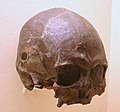
|
Tepexpan 1
Uomo di Tepexpan
|
4 700 anni
|
Homo sapiens
|
1947
|
Lago Texcoco, Messico
|
Helmut de Terra
|
[128]
|
Note
- ^ Prominent Hominid Fossils, su talkorigins.org.
- ^ La grande mischia dell'evoluzione umana, su biopills.net. URL consultato il 3 marzo 2024.
- ^ (EN) Sahelanthropus tchadensis, su becominghuman.org. URL consultato il 12 febbraio 2024.
- ^ (EN) Controversial Study Claims Apes and Human Ancestors Split in Southern Europe, su smithsonianmag.com. URL consultato il 10 maggio 2024.
- ^ (EN) BAR 1002'00, su humanorigins.si.edu. URL consultato il 14 maggio 2024.
- ^ (EN) Ardipithecus kadabba, su australian.museum. URL consultato il 18 maggio 2024.
- ^ (EN) Andrew Hill, Steven Ward e Barbara Brown, Anatomy and age of the Lothagam mandible, in Journal of Human Evolution, vol. 22, 1992, pp. 439-451, DOI:10.1016/0047-2484(92)90079-O, ISSN 0047-2484 (WC · ACNP).
- ^ Pliocene hominid partial mandible from Tabarin, Baringo, Kenya.
- ^ (EN) Ancient Skeleton Could Rewrite the Book on Human Origins, su washingtonpost.com. URL consultato il 21 maggio 2024.
- ^ Australopithecus anamensis: KNM-KP 29281, su efossils.org. URL consultato il 7 gennaio 2018.
- ^ (EN) Bryan Patterson, A New Locality for Early Pleistocene Fossils in North-Western Kenya, in Nature, vol. 212, 1966, DOI:10.1038/212577a0.
- ^ Laetoli - 3.5 Million Year Old Hominin Footprints in Tanzania.
- ^ Australopithecus afarensis: LH 4.
- ^ KNM-WT 40000.
- ^ (EN) Darryl E. Granger, Ryan J. Gibbon, Kathleen Kuman, Ronald J. Clarke, Laurent Bruxelles e Marc W. Caffee, New cosmogenic burial ages for Sterkfontein Member 2 Australopithecus and Member 5 Oldowan, in Nature, n. 522, Springer Nature, giugno 2015, pp. 85-88, DOI:10.1038/nature14268. URL consultato il 4 marzo 2019.
- ^ Australopithecus afarensis: AL 129-1.
- ^ (EN) Lucy's 'Child' Offers Rare Glimpse of an Ancient Toddler, su science.org. URL consultato il 27 aprile 2024.
- ^ Australopithecus afarensis: AL 200-1, su efossils.org, eFossils (website). URL consultato il 24 giugno 2013.
- ^ Australopithecus bahrelghazali.
- ^ (EN) Donald C. Johanson e Kate Wong, Lucy's Legacy: The Quest for Human Origins, Crown Publishing Group, 2010, pp. 8-9, ISBN 978-0-307-39640-2.
- ^ (EN) AL 444-2, su humanorigins.si.edu. URL consultato il 25 febbraio 2024.
- ^ Australopithecus africanus: Taung 1, su efossils.org. URL consultato il 20 dicembre 2017.
- ^ LD 350-1: Oldest Known Fossil of Genus Homo Found, su sci-news.com. URL consultato il 20 dicembre 2017.
- ^ Australopithecus africanus: Sts 71, su efossils.org. URL consultato il 20 dicembre 2017.
- ^ STS 71, su humanorigins.si.edu. URL consultato il 20 dicembre 2017.
- ^ Australopithecus africanus: Sts 52, su efossils.org. URL consultato il 20 dicembre 2017.
- ^ Australopithecus africanus: Sts 5, su efossils.org. URL consultato il 20 dicembre 2017.
- ^ Paranthropus aethiopicus: Omo 18-1967-18, su efossils.org. URL consultato il 20 dicembre 2017.
- ^ Paranthropus aethiopicus: KNM-WT 17000, su efossils.org. URL consultato il 20 dicembre 2017.
- ^ (EN) Marine Cazenave, Christopher Dean, Clément Zanolli, Anna C. Oettlé, Jakobus Hoffman, Mirriam Tawane, Francis Thackeray e Roberto Macchiarelli, Reassessment of the TM 1517 odonto-postcranial assemblage from Kromdraai B, South Africa, and the maturational pattern of Paranthropus robustus, in American journal of biological anthropology, 2020, DOI:10.1002/ajpa.24082.
- ^ Paranthropus robustus: SkK 48, su efossils.org. URL consultato il 20 dicembre 2017.
- ^ Una nuova specie: L'Homo gautengensis, su ilfattostorico.com. URL consultato il 21 dicembre 2017.
- ^ Reappraisal of the taxonomic status of the cranium Stw 53 from the Plio/Pleistocene of Sterkfontein, in South Africa, su link.springer.com. URL consultato il 21 dicembre 2017.
- ^ DNH 7, su humanorigins.si.edu. URL consultato il 2 marzo 2024.
- ^ Amos Jonathan, African fossils put new spin on human origins story, in https://www.sciencemag.org/site/extra/sediba/index.xhtml, BBC News, 8 settembre 2011. URL consultato il 9 settembre 2011.
- ^ (EN) Australopithecus sediba, su ebsco.com. URL consultato il 16 aprile 2025.
- ^ Mai, L.L., Owl, M.Y., & Kersting, M.P. (2005), p.286
- ^ Homo habilis: KNM-ER 1813, su efossils.org. URL consultato il 20 dicembre 2017.
- ^ (EN) OH5, su humanorigins.si.edu. URL consultato il 4 marzo 2024.
- ^ Homo habilis: OH 24, su efossils.org. URL consultato il 20 dicembre 2017.
- ^ Homo ergaster: SK 847, su efossils.org. URL consultato il 20 dicembre 2017.
- ^ SK 847, su humanorigins.si.edu. URL consultato il 20 dicembre 2017.
- ^ SK 46, su humanorigins.si.edu. URL consultato il 21 dicembre 2017.
- ^ Homo habilis: OH 7, su efossils.org. URL consultato il 20 dicembre 2017.
- ^ Homo habilis: OH 8, su efossils.org. URL consultato il 20 dicembre 2017.
- ^ Homo ergaster: KNM-ER 3733, su efossils.org. URL consultato il 20 dicembre 2017.
- ^ KNM-ER 406, su humanorigins.si.edu. URL consultato il 21 dicembre 2017.
- ^ KNM-ER 732 A, su humanorigins.si.edu. URL consultato il 21 dicembre 2017.
- ^ Homo habilis: OH 13, su efossils.org. URL consultato il 21 dicembre 2017.
- ^ Paranthropus boisei: Peninj 1, su efossils.org. URL consultato il 21 dicembre 2017.
- ^ Homo ergaster: KNM ER 992, su efossils.org. URL consultato il 21 dicembre 2017.
- ^ Homo ergaster: KNM-ER 3883, su efossils.org. URL consultato il 21 dicembre 2017.
- ^ Homo ergaster: KNM-WT 15000, su efossils.org. URL consultato il 21 dicembre 2017.
- ^ Konso KGA10-525, su humanorigins.si.edu. URL consultato il 21 dicembre 2017.
- ^ (EN) OH 9, su humanorigins.si.edu. URL consultato il 10 marzo 2024.
- ^ (EN) Sangiran 2, su humanorigins.si.edu. URL consultato il 10 marzo 2024.
- ^ (EN) G. Philip Rightmire, The Evolution of Homo Erectus: Comparative Anatomical Studies of an Extinct Human Species, Cambridge University Press, 1990, pp. 20-21, ISBN 0521449987.
- ^ Homo erectus: Trinil 2, su efossils.org. URL consultato il 21 dicembre 2017.
- ^ (EN) J. M. Bermúdez de Castro, J. L. Arsuaga, E. Carbonell, A. Rosas, I. Martı́nez e M. Mosquera, A Hominid from the Lower Pleistocene of Atapuerca, Spain: Possible Ancestor to Neandertals and Modern Humans, in Science, vol. 276, 1997, pp. 1392-1395, DOI:10.1126/science.276.5317.1392.
- ^ Homo erectus: Peking Man, su efossils.org. URL consultato il 21 dicembre 2017.
- ^ (EN) Homo erectus: Sangiran 17, su efossils.org. URL consultato il 23 dicembre 2017.
- ^ (EN) Ternifine, anthropological and archaeological site, Algeria, su britannica.com. URL consultato il 14 marzo 2024.
- ^ (EN) Bodo, su humanorigins.si.edu. URL consultato il 16 marzo 2024.
- ^ Otto Schoetensack, Der Unterkiefer des Homo Heidelbergensis aus den Sanden von Mauer bei Heidelberg. Ein Beitrag zur Paläontologie des Menschen. Leipzig, 1908, Verlag von Wilhelm Engelmann.
- ^ Admin, Il bambino d'Isernia: l'iniziativa di Focus Junior per trovare un nome al bambino preistorico, su Focus Scuola, 15 giugno 2022. URL consultato il 1º aprile 2025.
- ^ Ascenzi A. & A. G. Segre, 1997: Resti di cranio umano del Pleistocene medio-inferiore a Ceprano. Rendiconti Accademia Nazionale dei Lincei, Classe Sc. Mat Nat., ser. 9, 8 (1): 39-67. Abstract consultabile all'indirizzo: http://www.springerlink.com/content/9350618346423382
- ^ Saldanha, su humanorigins.si.edu. URL consultato il 24 dicembre 2017.
- ^ (EN) Scientists discover hominid cranium in Ethiopia: IU News Room: Indiana University, su newsinfo.iu.edu. URL consultato il 13 aprile 2024.
- ^ Arago 21, su humanorigins.si.edu. URL consultato il 24 dicembre 2017.
- ^ (EN) Hexian, su humanorigins.si.edu. URL consultato il 20 marzo 2024.
- ^ (FR) Homo heidelbergensis « protonéanderthalien », AT 700, «Miguelón», su aiptautavel.fr. URL consultato il 21 marzo 2024.
- ^ Steinheim, su humanorigins.si.edu. URL consultato il 24 dicembre 2017.
- ^ Ndutu, su humanorigins.si.edu. URL consultato il 24 dicembre 2017.
- ^ Petralona 1, su humanorigins.si.edu. URL consultato il 24 dicembre 2017.
- ^ (EN) Ewan Callaway, Oldest Homo sapiens fossil claim rewrites our species' history, in Nature, 7 giugno 2017, DOI:10.1038/nature.2017.22114. URL consultato il 4 settembre 2017.
- ^ (EN) Dali, su britannica.com. URL consultato il 3 aprile 2024.
- ^ (EN) Kabwe cranium, su britannica.com. URL consultato il 4 aprile 2024.
- ^ Salé, su humanorigins.si.edu. URL consultato il 24 dicembre 2017.
- ^ Ngandong 7, su humanorigins.si.edu. URL consultato il 24 dicembre 2017.
- ^ (EN) Omo I, su humanorigins.si.edu. URL consultato il 24 dicembre 2017.
- ^ (EN) R. E. F. Leakey, Early Homo sapiens Remains from the Omo River Region of South-west Ethiopia: Faunal Remains from the Omo Valley, in Nature, 1969, pp. 1132-1133, DOI:10.1038/2221132a0.
- ^ Bob Yirka, Altamura Man yields oldest Neanderthal DNA sample, su Phys.org, 3 aprile 2015. URL consultato il 2 gennaio 2017.
- ^ (EN) White, Tim D., Asfaw, Berhane, DeGusta, David, Gilbert, Henry, Richards, Gary D., Suwa, Gen e Clark Howell, F., Pleistocene Homo sapiens from Middle Awash, Ethiopia, in Nature, vol. 423, 2003, DOI:10.1038/nature01669.
- ^ (EN) Gibbons, Anne, First fossil jaw of Denisovans finally puts a face on elusive human relatives, su science.org. URL consultato il 18 luglio 2024.
- ^ (EN) Qiaomei Fu, Peng Cao, Qingyan Dai, Bennett, E. Andrew, Feng, Xiaotian, Yang, Melinda A., Ping, Wanjing, Pääbo, Svante e Ji, Qiang, Denisovan mitochondrial DNA from dental calculus of the >146,000-year-old Harbin cranium, in Cell, vol. 0, n. 0, 18 giugno 2025, DOI:10.1016/j.cell.2025.05.040. URL consultato il 23 giugno 2025.
- ^ Krapina 3, su humanorigins.si.edu. URL consultato il 24 dicembre 2017.
- ^ Saccopastore 1, su humanorigins.si.edu. URL consultato il 26 dicembre 2017.
- ^ Tabun 1, su humanorigins.si.edu. URL consultato il 24 dicembre 2017.
- ^ Ngaloba LH 18, su humanorigins.si.edu. URL consultato il 24 dicembre 2017.
- ^ (EN) Qafzeh 6, su humanorigins.si.edu. URL consultato il 14 aprile 2024.
- ^ Skhūl V, su humanorigins.si.edu. URL consultato il 24 dicembre 2017.
- ^ (EN) D. Coutinho Nogueira, O. Dutour, H. Coqueugniot e A.-m. Tillier, Qafzeh 9 mandible (ca 90–100 kyrs BP, Israel) revisited: μ-CT and 3D reveal new pathological conditions, in International Journal of Paleopathology, 2019, pp. 104-110, DOI:10.1016/j.ijpp.2019.06.002, ISSN 1879-9817 (WC · ACNP).
- ^ (EN) Revisiting Homo floresiensis, su creation.com. URL consultato il 24 aprile 2024.
- ^ La Ferrassie, su humanorigins.si.edu. URL consultato il 24 dicembre 2017.
- ^ Gibraltar 1, su humanorigins.si.edu. URL consultato il 26 dicembre 2017.
- ^ La Quina 5, su humanorigins.si.edu. URL consultato il 24 dicembre 2017.
- ^ La Quina 18, su humanorigins.si.edu. URL consultato il 24 dicembre 2017.
- ^ (EN) Y. Rak, W.H. Kimbel e E. Hovers, A Neandertal infant from Amud Cave, Israel, in Journal of Human Evolution, vol. 26, 1994, pp. 313-324, DOI:10.1006/jhev.1994.1019, ISSN 0047-2484 (WC · ACNP).
- ^ (EN) Homo neanderthalensis: Guattari 1, su efossils.org. URL consultato il 19 aprile 2024.
- ^ (EN) Aart Berkhout, Frank Huffman e Aart W. Berkhout, Provenience Reassessment of the 1931–1933 Ngandong Homo erectus (Java), Confirmation of the Bone-Bed Origin Reported by the Discoverers.
- ^ La Chapelle-aux-Saints, su efossils.org. URL consultato il 26 dicembre 2017.
- ^ Homo neanderthalensis: Neanderthal 1, su efossils.org. URL consultato il 24 dicembre 2017.
- ^ (EN) Le Moustier, su britannica.com. URL consultato il 21 aprile 2024.
- ^ Shanidar 1, su humanorigins.si.edu. URL consultato il 26 dicembre 2017.
- ^ Le ibridazioni tra Homo sapiens e Neanderthal erano frequenti anche in Europa | Il Bo Live UniPD, su ilbolive.unipd.it, 15 aprile 2021. URL consultato il 12 maggio 2025.
- ^ (EN) Oase 2, su humanorigins.si.edu. URL consultato il 21 aprile 2024.
- ^ Amud, su humanorigins.si.edu. URL consultato il 26 dicembre 2017.
- ^ Jon M. Olleya, Richard G. Roberts, Hiroyuki Yoshida, James M.Bowler, Single-grain optical dating of grave-infill associated with human burials at Lake Mungo, Australia., su: Quaternary Science Reviews, Volume 25, Issues 19–20, October 2006, Pages 2469-2474.
- ^ Grine, Fe; Bailey, Rm; Harvati, K; Nathan, Rp; Morris, Ag; Henderson, Gm; Ribot, I; Pike, Aw, Late Pleistocene human skull from Hofmeyr, South Africa, and modern human origins, in Science, vol. 315, n. 5809, gennaio 2007, pp. 226-9, Bibcode:2007Sci...315..226G, DOI:10.1126/science.1136294, ISSN 0036-8075 (WC · ACNP), PMID 17218524.
- ^ (EN) Andaine Seguin-Orlando, Thorfinn S. Korneliussen, Martin Sikora, Anna-Sapfo Malaspinas, Andrea Manica, Ida Moltke, Anders Albrechtsen, Amy Ko, Ashot Margaryan, Vyacheslav Moiseyev, Ted Goebel, Michael Westaway, David Lambert, Valeri Khartanovich, Jeffrey D. Wall, Philip R. Nigst, Robert A. Foley, Marta Mirazon Lahr, Rasmus Nielsen, Ludovic Orlando e Eske Willerslev, Genomic structure in Europeans dating back at least 36,200 years, in Science, 346}, 2014, pp. 1113-1118, DOI:10.1126/science.aaa0114. URL consultato il 5 maggio 2025.
- ^ Homo sapiens: Cro-Magnon 1, su efossils.org. URL consultato il 24 dicembre 2017.
- ^ (EN) Clark Spencer Larsen, Robert M. Matter e Daniel Lee Gebo, Human origins: the fossil record, Waveland Press, 1988, ISBN 1577660021.
- ^ (EN) Suzuki, Hisashi e Hanihara, Kazurō, The Minatogawa Man : The upper Pleistocene man from the island of Okinawa, University of Tokyo Press, 1982, ISBN 0860082997.
- ^ (EN) Chancelade skeleton, su britannica.com. URL consultato il 3 maggio 2024.
- ^ (EN) Allsworth-Jones P., Harvati, K. e Stringer, C., The archaeological context of the Iwo Eleru cranium from Nigeria and preliminary results of new morphometric studies, West African Archaeology New developments, new perspectives, 2010, pp. 29-42, ISBN 978 1 4073 0708 4.
- ^ Ripari Villabruna (sito pluristratificato), su catalogo.beniculturali.it. URL consultato il 2 maggio 2024.
- ^ Paleoantropologia, su treccani.it. URL consultato il 30 aprile 2024.
- ^ (EN) Lapa Vermelha IV Hominid 1, su humanorigins.si.edu. URL consultato il 2 maggio 2024.
- ^ (EN) John C. Merriam, Preliminary Report on the Discovery of Human Remains in an Asphalt Deposit at Rancho La Brea, in Science, vol. 40, 1914, pp. 198-203, DOI:10.1126/science.40.1023.198.
- ^ (EN) Kow Swamp, su humanorigins.si.edu. URL consultato il 1º maggio 2024.
- ^ "7601–7547 cal BC, 95.4%", Almut Hoffmann et al.: The Homo aurignaciensis hauseri from Combe-Capelle - A Mesolithic burial. Journal of Human Evolution 61(2), 2011, S. 211–214 doi:10.1016/j.jhevol.2011.03.001.
- ^ L'uomo di Cheddar non assomiglia a nessun uomo che potremmo vedere oggi, su lastoriaviva.it. URL consultato il 26 aprile 2024.
- ^ (EN) University of Minnesota, Academics Archaeology, 1932 to the 1970s, su anthropology.umn.edu, 21 agosto 2012. URL consultato il 14 ottobre 2019 (archiviato dall'url originale il 26 maggio 2013).
- ^ (EN) Loschbour Man, su today.rtl.lu. URL consultato il 25 aprile 2024.
- ^ (EN) How Farming Reshaped Our Genomes, su www.science.org. URL consultato il 22 aprile 2025.
- ^ (EN) Asselar man, su britannica.com. URL consultato il 29 aprile 2024.
- ^ Risale al 3200 AC l'uomo del Similaun. URL consultato il 29 aprile 2024.
- ^ (EN) Tepexpan 1, su humanorigins.si.edu. URL consultato il 26 aprile 2024.
Bibliografia
- Tattersall Ian, Schwartz Jeffery, Extinct Humans, Westview Press, Boulder CO, 2000, ISBN 978-0-8133-3482-0.
- Larsen Clark Spencer, Matter Robert M, Gebo Daniel L, Human Origins: the fossil record, Waveland Press, Prospect Heights, IL, 1991, ISBN 978-0-88133-575-0.
- Gibbons, Ann. The First Human: The Race to Discover our Earliest Ancestor. Anchor Books (2007). ISBN 978-1-4000-7696-3
- Walter Carl Hartwig, The Primate Fossil Record, a cura di Hartwig, Walter, Cambridge University Press, 2004, Bibcode:2002prfr.book.....H, ISBN 978-0-521-08141-2.
- Johanson, Donald & Wong, Kate. Lucy's Legacy: The Quest for Human Origins. Three Rivers Press (2009). ISBN 978-0-307-39640-2
- Jones, Steve, Martin, Robert D. e Pilbeam, David R (a cura di), The Cambridge Encyclopedia of Human evolution, Cambridge University Press, 1994, ISBN 978-0-521-46786-5. (Note: this book contains very useful, information dense chapters on primate evolution in general, and human evolution in particular, including fossil history).
- (EN) Leakey, Richard e Lewin, Roger, Origins Reconsidered: In Search of What Makes us Human, Little, Brown and Company, 1992, ISBN 0385467923.
- Lewin, Roger. Bones of Contention: Controversies in the Search for Human Origins. Penguin Books (1987). ISBN 0-14-022638-9
- Morwood, Mike & van Oosterzee, Penny. A New Human: The Startling Discovery and Strange Story of the 'Hobbits' of Flores, Indonesia. Smithsonian Books (2007). ISBN 978-0-06-089908-0
- Oppenheimer, Stephen. Out of Eden: The Peopling of the World. Constable (2003). ISBN 1-84119-697-5
- Roberts, Alice. The Incredible Human Journey: The Story of how we Colonised the Planet. Bloomsbury (2009). ISBN 978-0-7475-9839-8
- Shreeve, James. The Neanderthal Enigma: Solving the Mystery of Modern Human Origins. Viking (1996). ISBN 0-670-86638-5
- Stringer, Chris. The Origin of Our Species. Allen Lane (2011). ISBN 978-1-84614-140-9
- Stringer, Chris & Andrews, Peter. The Complete World of Human Evolution. Thames & Hudson (2005). ISBN 0-500-05132-1
- Stringer, Chris & McKie, Robin. African Exodus: The Origins of Modern Humanity. Jonathan Cape (1996). ISBN 0-224-03771-4
- van Oosterzee, Penny. The Story of Peking Man. Allen & Unwin (1999). ISBN 1-86508-632-0
- Walker, Allan & Shipman, Pat. The Wisdom of the Bones: In Search of Human Origins. Weidenfeld & Nicolson (1996). ISBN 0-297-81670-5
- Wade, Nicholas. Before the Dawn: Recovering the Lost History of our Ancestors. Penguin Press (2006). ISBN 978-0-7156-3658-9
- Weiss, M.L. e Mann, A.E., Human Biology and Behaviour: An anthropological perspective, 4th, Boston, Little Brown, 1985, ISBN 978-0-673-39013-4. (Note: this book contains very accessible descriptions of human and non-human primates, their evolution, and fossil history).
- Spencer Wells, The Journey of Man: A Genetic Odyssey, New York, Random House Trade Paperbacks, 2004, ISBN 978-0-8129-7146-0.
Voci correlate
Altri progetti
Collegamenti esterni
|



























































































































